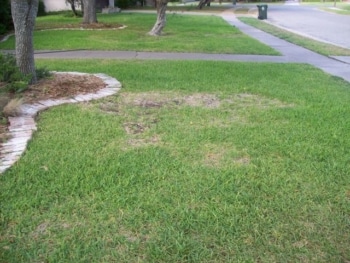 “Lawn disease” is a convenient term that’s used to describe a variety of issues. But it’s important to know exactly what you’re dealing with so you can apply the most effective treatment.
“Lawn disease” is a convenient term that’s used to describe a variety of issues. But it’s important to know exactly what you’re dealing with so you can apply the most effective treatment.
The truth is, fungus may be the biggest culprit of them all when it comes to truly damaging lawn intruders. Sure, there are some major players to contend with- like crabgrass, for instance. But fungus, as a category, offers a whole host of diseases that are often well-established before they become visible.
While “large patch” and “brown patch” diseases are sometimes referenced interchangeably, they are actually different pathogens with slightly different features. They both come from the family Rhizoctonia solani, but they are separate species, and tend to affect different grass types.
In this article, we will discuss the signs, causes, and treatments for large patch lawn disease versus brown patch lawn disease
Identification
The main visual distinction between large patch and brown patch is actually implied in their names. Both diseases create large and unsightly patches of ailing grass in your lawn.
With large patch fungus, the affected area will have a ring of yellow or orange grass blades that remain somewhat upright. But with brown patch fungus, the blades will wilt and flatten, eventually turning brown. They will also have a dark “smoke ring” along the perimeter, that is sometimes only noticeable in early morning.
Both diseases can also be mistaken with insect-related issues, such as excessive grub worms. However, there are ways to differentiate between the two pretty easily, which we will explore in the section about how these fungi affect your lawn.
Another simple distinction lies in which turfgrass you’ve chosen for your lawn. Large patch affects common warm-season grasses, such as Zoysia grass and St. Augustine grass. These grass breeds are widely popular in the North Texas area, meaning a mystery fungus in your lawn is more likely to be large patch rather than brown patch.
Brown patch fungus affects cool-season grassescool-season grasses, and is most prolific with grass types such as Ryegrass, Bluegrass, and Fescues. However, that doesn’t mean your North Texas lawn is completely safe from brown grass fungus.
Disease Process
Both types of fungus have a similar disease process when it comes to how they damage your lawn. They infect your grass as the level of the stolon, where the blades come together above the root system. This means the thatch, roots, stems, and blades all end up with the infection if it goes on long enough.
This is exactly why treating fungus preventively is critical. Just like some invasive grass species, large patch and brown patch fungus can be off and running- completely out of control- by the time it’s truly noticeable in your lawn.
In a moment, we will discuss effective measures you can take to stay ahead of the curve.
If you’re not sure whether you’re dealing with fungus or insect larvae, simply pull up a few blades. Both problems create spots of dying and discolored grass, but there are a few differences.
With a fungal infection, the grass will pull up easily, and you will be able to see brown lesions along the lower portion of the stems. Additionally, the blades will remain intact even as they rot and become discolored. Conversely, grass that is being eaten by insect larvae will literally look ragged and chewed up.
Causes and Prevention
Here is where it is most important to draw a few distinctions between large patch fungus versus brown patch fungus. Preventive measure between the two are quite similar, but their preferred growth environments are a bit different.
Large Patch Fungus
The fungus that causes large patch disease tends to spread in temperatures remain below 70 degrees Fahrenheit. This means it can crop up in early spring, or later on during the fall when the air begins to cool.
As with all lawn care issues, the best way to problem-solve is to take a look at what the disease prefers, and work to prevent those conditions from developing. Large patch prefers areas with excess shade, moisture, and nitrogen. Additionally, it develops in the thatch layer of your grass bed.
Taking a que from those conditions, it is easy to conclude the following:
- Dethatching and aerating will disrupt the disease’s preferred growth environment, making it more difficult for the fungus to spread. Not sure how to go about this task? Visit our service page for aerating your lawn.
- Watering only as much as needed- and watering less if there is evidence of lawn disease- will help stop it from spreading.
- Testing your soil is wise, so you can use a fertilizer ratio that only provides the amount of nutrients needed to keep your grass healthy but nothing more. This is especially true with nitrogen, which is the most common ingredient in common North Texas fertilizers.
- Do NOT use fast-release nitrogen in areas affected with fungal disease!
- Addressing areas of poor drainage can help prevent large patch and many other moisture-based lawn issues. Learn more about moisture management from Ryno Lawn Care.
- If you have removable structures that are creating excess shade, consider relocating them or taking them down if you’re battling these fungal diseases.
- Thinning out nearby trees and shrubs can also reduce shade coverage, allowing increased sun exposure to stave off the spread of fungal spores.
Fungicides are effective in treating large patch and brown patch infections, but not nearly so much once the infection has begun to spread. Using a fungicide preventively keeps you a step ahead of the disease process. This means it should be applied before temperatures exceed 70 in the spring, and after they’ve dropped to 70 in the fall.
Brown Patch Fungus
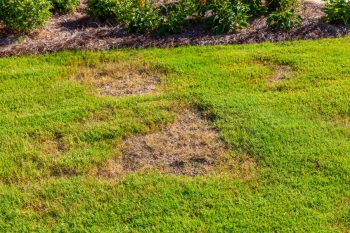 This foe favors many of the same conditions as brown patch fungus. Therefore, much of the same preventive measures will be employed to combat brown patch disease, such as reducing excess water, nitrogen, thatch, and shade.
This foe favors many of the same conditions as brown patch fungus. Therefore, much of the same preventive measures will be employed to combat brown patch disease, such as reducing excess water, nitrogen, thatch, and shade.
However, brown patch fungus really loves warm weather. It becomes active at about 65 degrees Fahrenheit, and will spread more fervently when the daily temperatures are averaging 80-85 degrees.
High humidity can also accelerate its growth, which makes any established infection especially threatening in our humid North Texas springs and summers.
Final Thoughts
- If you lawn has warm-season grass, you are more likely to experience large patch than brown patch, although they are similar infections.
- Brown patch fungus is more likely to attack cool-season grasses during the hottest times of year.
- Both diseases thrive on excess shade, moisture, thatch, and nitrogen. Addressing these issues are great preventive measures.
- Applying a fungicide when the temperatures reach 70 degrees Fahrenheit is an effective treatment, though it works best preventively.
- If the grass blades pull up easily and do not look chewed on, this is a sure way to know you’re dealing with fungus rather than insects.
Need some help with seasonal lawn care issues? Click here for a free service quote!

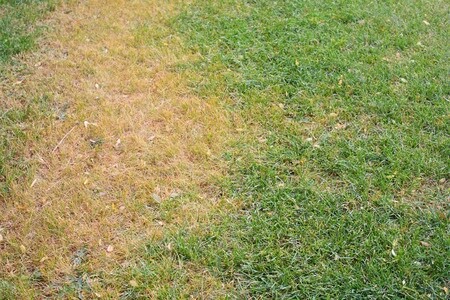

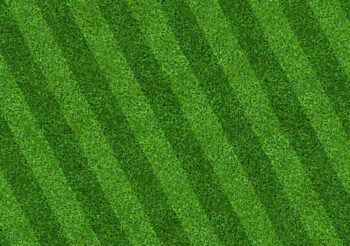
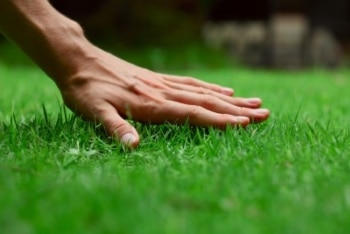
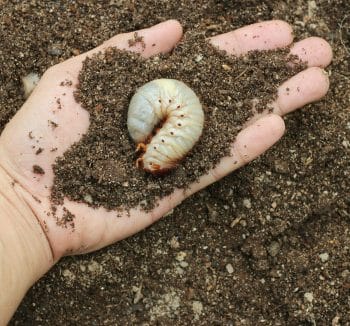
3 Responses
Great article! We about to see a lot of that coming soon! I appreciate this information, most of our customers do not know the difference. I am glad to have a resource to send them to.
Excellent article on how to identify if the brown patch in your yard is a fungus or not. I also think doing a soil test is one of the best things a homeowner can do to keep their yards healthy.
Great Post. Thanks for sharing.